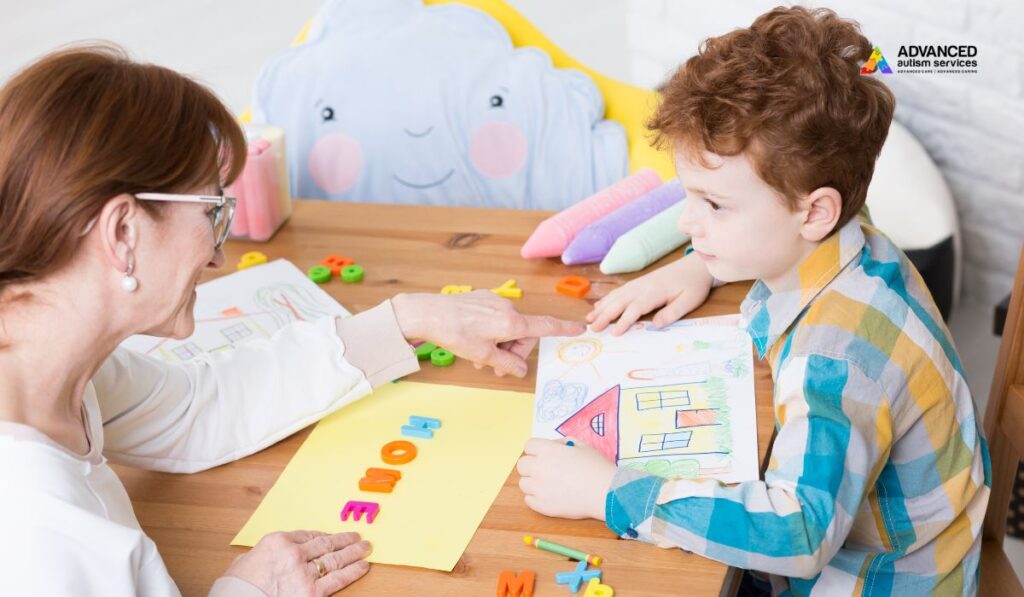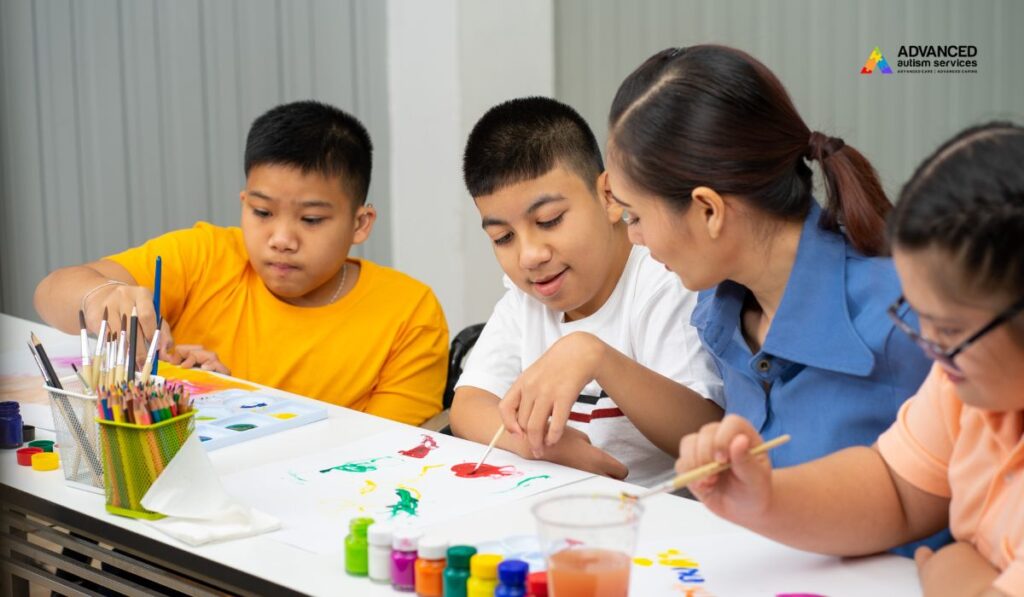Autism Spectrum Disorder (ASD) is a neurodevelopmental condition characterized by challenges in social interaction, communication, and repetitive behaviors. While Applied Behavior Analysis (ABA) therapy is widely recognized for its effectiveness in addressing these core challenges, it also holds great potential in fostering creativity and artistic talents in children with ASD. This article explores the intersection of ABA therapy and the promotion of creativity and arts in talented ASD kids, shedding light on the holistic approach that can enhance their overall well-being.
Understanding Autism Spectrum Disorder
Before delving into the relationship between ABA therapy and creativity in ASD children, it is crucial to understand the diverse nature of ASD. Children with ASD often exhibit a wide range of strengths and challenges, making each unique. Some children may have exceptional talents in specific areas, including the arts while facing difficulties in other aspects of daily life.
The Role of ABA Therapy
Applied Behavior Analysis (ABA) in Phoenix, AZ, is a personalized therapeutic approach grounded in learning and behavior principles. Tailored to individuals with Autism Spectrum Disorder (ASD), it focuses on specific behaviors to enhance social skills, communication, and adaptive functioning. ABA therapy utilizes positive reinforcement to encourage desired behaviors while mitigating challenging ones. By maintaining a structured and consistent environment, it creates a supportive framework for children with ASD in Phoenix, AZ, to flourish and reach their full potential.
Encouraging Creativity Through ABA Therapy
Creativity is a fundamental aspect of human expression, and fostering it in children with ASD is essential for their overall development. ABA therapy can be adapted to incorporate creative activities, providing a unique avenue for these children to explore and express their talents. Here are several ways in which ABA therapy can nurture creativity in ASD kids:
Individualized Goal Setting
ABA therapy places a strong emphasis on crafting individualized treatment plans tailored to meet the specific needs and strengths of each child. Through the identification and incorporation of creative goals, therapists play a pivotal role in assisting children to develop and showcase their artistic abilities. This personalized approach within ABA therapy ensures that artistic expression becomes an integral part of a child’s developmental journey, fostering a sense of accomplishment and self-discovery in the process.
Structured Routine with Creative Breaks
Maintaining a structured routine is essential for children with Autism Spectrum Disorder (ASD). However, incorporating creative breaks into their schedule offers them valuable opportunities to explore artistic pursuits. These breaks serve as a platform for self-expression, whether through activities like painting, music, or other creative outlets. This balance between routine and creative exploration not only supports their developmental needs but also encourages a well-rounded and fulfilling experience.
Social Skills Development through Arts
Engaging in various creative activities fosters collaboration and communication. In Phoenix, AZ, Applied Behavior Analysis strategically incorporates group activities centered around the arts. This provides children with Autism Spectrum Disorder (ASD) valuable opportunities to enhance social skills and express themselves creatively, ensuring a holistic approach to their overall development. Explore the transformative impact of applied behavior analysis in Phoenix az on children’s growth.
Positive Reinforcement for Artistic Achievements
ABA therapy relies on positive reinforcement as a cornerstone for encouraging desired behaviors. Acknowledging and reinforcing artistic achievements within this framework can significantly boost a child’s confidence and motivation, inspiring them to further explore and develop their creative talents. This positive cycle not only strengthens the effectiveness of ABA therapy but also contributes to the child’s overall sense of accomplishment and well-being.
Utilizing Special Interests
Children with Autism Spectrum Disorder (ASD) often display intense and specific interests. ABA therapists skillfully incorporate these individual interests into creative activities, making the learning process more engaging and enjoyable for the child. This personalized approach not only aligns with the child’s passions but also amplifies the effectiveness of ABA therapy by establishing a tailored and motivating environment for exploration and skill development.
If you are seeking ABA providers in Phoenix, AZ, Advanced Autism Services is dedicated to providing exceptional services. Our commitment is to support the unique needs of children with ASD, fostering growth, and enhancing their overall well-being.
Conclusion
In conclusion, the intersection of ABA therapy and the promotion of creativity and arts in talented ASD kids is a promising avenue for holistic development. By recognizing and incorporating creative goals into individualized treatment plans, ABA therapists can provide children with ASD the opportunity to express themselves, develop social skills, and showcase their unique talents. Through positive reinforcement and a structured yet flexible approach, ABA therapy contributes to the overall well-being of these children, fostering a sense of accomplishment and self-discovery that extends beyond the therapeutic setting. As we continue to explore the diverse strengths of children with ASD, embracing creativity through ABA therapy opens doors to new possibilities and a brighter future for these exceptional individuals.
FAQs
How does ABA therapy specifically address the unique challenges faced by children with Autism Spectrum Disorder (ASD), and how does it go beyond traditional approaches to promote overall well-being?
ABA therapy is a behavior-focused intervention that meticulously analyzes and targets specific behaviors associated with ASD. Unlike traditional approaches, ABA therapy is highly individualized, allowing therapists to tailor strategies to each child’s unique strengths and challenges. By promoting positive behaviors and reducing challenging ones, ABA therapy contributes not only to behavioral improvements but also to the overall well-being of children with ASD.
Can you provide examples of creative goals within ABA therapy, and how are these goals customized to suit the individual strengths and talents of each child with ASD?
Creative goals within ABA therapy may include engaging in art projects, exploring music, or participating in drama activities. These goals are customized by aligning them with a child’s specific interests and strengths. For instance, if a child has a keen interest in visual arts, the creative goals may involve painting or sculpting activities, ensuring a personalized and enjoyable approach.
In what ways can ABA therapy incorporate structured routines while allowing for creative breaks to support artistic exploration in children with ASD?
ABA therapy maintains a structured routine, providing predictability for children with ASD. To support artistic exploration, therapists can strategically incorporate creative breaks within this routine. These breaks allow children to engage in artistic activities, fostering self-expression and creativity while maintaining the overall structure that is beneficial for individuals with ASD.
Are there specific strategies within ABA therapy that focus on developing social skills through artistic activities, and how do these contribute to improved communication and collaboration?
Yes, ABA therapy can integrate group activities centered around the arts to develop social skills. Collaborative artistic endeavors encourage communication, teamwork, and the sharing of ideas. These activities create a positive social environment, contributing to improved communication and collaboration skills in children with ASD.
How does positive reinforcement play a role in encouraging artistic achievements in children with ASD during ABA therapy sessions, and what are the long-term benefits of this approach?
Positive reinforcement is a cornerstone of ABA therapy, where desired behaviors, including artistic achievements, are rewarded. This approach motivates children to explore and develop their creative talents. Over time, positive reinforcement fosters confidence, self-esteem, and a sustained interest in artistic pursuits.
Can you elaborate on how ABA therapists leverage the special interests of children with ASD to enhance engagement and enjoyment in creative activities?
ABA therapists skillfully identify and integrate a child’s special interests into creative activities, thereby enhancing the engagement and enjoyment of the learning process. Aligning creative pursuits with these specific interests allows therapists to tap into the child’s intrinsic motivation, fostering active participation and a sustained enjoyment of artistic endeavors. This tailored approach not only supports the child’s individual preferences but also contributes to a more fulfilling and effective therapeutic experience.
How can parents collaborate with ABA therapists to ensure that creative pursuits align with their child’s unique needs and preferences, and what role can parents play in reinforcing artistic development at home?
Open communication between parents and ABA therapists is crucial. Parents can share insights into their child’s interests and preferences, enabling therapists to tailor creative activities accordingly. Additionally, parents play a vital role in reinforcing artistic development at home by encouraging and participating in creative activities with their children.
Are there documented case studies or success stories that showcase the positive impact of ABA therapy in fostering creativity and artistic talents in children with ASD?
Yes, numerous case studies and success stories highlight the positive impact of ABA therapy on fostering creativity in children with ASD. These narratives demonstrate the potential for artistic development and overall well-being when ABA therapy is thoughtfully integrated into the lives of these exceptional individuals.
Looking towards the future, how can the intersection of ABA therapy and creativity contribute to a more inclusive and supportive environment for individuals with Autism Spectrum Disorder, both within therapeutic settings and in society at large?
The integration of ABA therapy and creativity holds the promise of creating a more inclusive and supportive environment for individuals with ASD. By recognizing and nurturing artistic talents, society can embrace the diverse strengths of individuals with ASD, fostering a more understanding and inclusive community. Therapeutic settings can continue to evolve to provide comprehensive support that extends beyond behavioral challenges, acknowledging and celebrating the unique talents of each individual.




